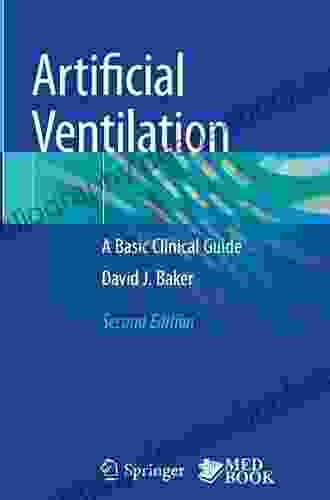Artificial Ventilation: Basic Clinical Guide for Healthcare Professionals

Artificial ventilation is a life-saving procedure that provides mechanical support for breathing. It is used in patients who are unable to breathe adequately on their own, such as those with respiratory failure, severe pneumonia, or trauma. Artificial ventilation can be delivered through a variety of methods, including invasive mechanical ventilation (IMV),non-invasive mechanical ventilation (NIV),and manual ventilation.
Indications for Artificial Ventilation
The decision to initiate artificial ventilation is based on a number of factors, including the patient's clinical condition, respiratory status, and underlying medical history. Some of the most common indications for artificial ventilation include:
4.4 out of 5
| Language | : | English |
| File size | : | 23693 KB |
| Text-to-Speech | : | Enabled |
| Screen Reader | : | Supported |
| Enhanced typesetting | : | Enabled |
| Print length | : | 473 pages |
- Respiratory failure
- Severe pneumonia
- Trauma
- Neuromuscular disorders
- Overdose of drugs or alcohol
Types of Artificial Ventilation
There are two main types of artificial ventilation: invasive mechanical ventilation (IMV) and non-invasive mechanical ventilation (NIV). IMV is delivered through a tube that is inserted into the patient's airway. NIV is delivered through a mask or nasal cannula that is placed over the patient's nose and mouth.
Invasive Mechanical Ventilation (IMV)
IMV is the most common type of artificial ventilation. It is used in patients who are unable to breathe adequately on their own, and who require a high level of respiratory support. IMV is delivered through a tube that is inserted into the patient's airway, either through the mouth (orotracheal intubation) or through the nose (nasotracheal intubation). The tube is connected to a ventilator, which provides mechanical support for breathing.
Non-Invasive Mechanical Ventilation (NIV)
NIV is a less invasive form of artificial ventilation that is used in patients who are able to breathe spontaneously but who require additional respiratory support. NIV is delivered through a mask or nasal cannula that is placed over the patient's nose and mouth. The mask or cannula is connected to a ventilator, which provides mechanical support for breathing.
Ventilator Settings
The ventilator settings are determined by the patient's clinical condition and respiratory status. The most common ventilator settings include:
- Tidal volume
- Respiratory rate
- Positive end-expiratory pressure (PEEP)
- Fraction of inspired oxygen (FiO2)
Tidal Volume
Tidal volume is the volume of gas that is delivered to the patient with each breath. The tidal volume is typically set between 6 and 8 mL/kg of ideal body weight.
Respiratory Rate
Respiratory rate is the number of breaths that the ventilator delivers per minute. The respiratory rate is typically set between 12 and 20 breaths per minute.
Positive End-Expiratory Pressure (PEEP)
PEEP is the amount of pressure that is applied to the lungs at the end of expiration. PEEP helps to keep the lungs open and prevent them from collapsing. The PEEP is typically set between 5 and 10 cmH2O.
Fraction of Inspired Oxygen (FiO2)
FiO2 is the concentration of oxygen in the gas that is delivered to the patient. The FiO2 is typically set between 0.21 (room air) and 1.0 (100% oxygen).
Ventilator Management
Ventilator management is a complex process that requires careful monitoring of the patient's clinical condition and respiratory status. The ventilator settings are adjusted as needed to meet the patient's changing needs. Ventilator management also includes monitoring for complications, such as ventilator-associated pneumonia (VAP) and ventilator-induced lung injury (VILI).
Ventilator Weaning
Ventilator weaning is the process of gradually reducing the level of ventilatory support and allowing the patient to breathe spontaneously. Ventilator weaning is started when the patient is stable and able to tolerate a reduction in ventilatory support. The ventilator settings are gradually reduced until the patient is able to breathe spontaneously without assistance.
Artificial ventilation is a life-saving procedure that provides mechanical support for breathing. It is used in patients who are unable to breathe effectively on their own.
The decision to initiate artificial ventilation is based on a number of factors, including the patient's clinical condition, respiratory status, and underlying medical history.
There are two main types of artificial ventilation: invasive mechanical ventilation (IMV) and non-invasive mechanical ventilation (NIV).
Ventilator settings are determined by the patient's clinical condition and respiratory status.
Ventilator management is a complex process that requires careful monitoring of the patient's clinical condition and respiratory status.
Ventilator weaning is the process of gradually reducing the level of ventilatory support and allowing the patient to breathe spontaneously.
4.4 out of 5
| Language | : | English |
| File size | : | 23693 KB |
| Text-to-Speech | : | Enabled |
| Screen Reader | : | Supported |
| Enhanced typesetting | : | Enabled |
| Print length | : | 473 pages |
Do you want to contribute by writing guest posts on this blog?
Please contact us and send us a resume of previous articles that you have written.
 Novel
Novel Chapter
Chapter Text
Text Genre
Genre Reader
Reader E-book
E-book Magazine
Magazine Newspaper
Newspaper Sentence
Sentence Shelf
Shelf Bibliography
Bibliography Footnote
Footnote Manuscript
Manuscript Scroll
Scroll Codex
Codex Bestseller
Bestseller Library card
Library card Narrative
Narrative Biography
Biography Autobiography
Autobiography Memoir
Memoir Encyclopedia
Encyclopedia Dictionary
Dictionary Thesaurus
Thesaurus Narrator
Narrator Character
Character Resolution
Resolution Librarian
Librarian Catalog
Catalog Borrowing
Borrowing Reserve
Reserve Journals
Journals Reading Room
Reading Room Rare Books
Rare Books Literacy
Literacy Study Group
Study Group Storytelling
Storytelling Book Club
Book Club Theory
Theory Textbooks
Textbooks J E Feldman
J E Feldman Riley Ohler
Riley Ohler Julian Havil
Julian Havil Lea M Mcgee
Lea M Mcgee Frank Schmalleger
Frank Schmalleger Elizabeth Heath
Elizabeth Heath Leanne Rozell
Leanne Rozell Tony Konieczny
Tony Konieczny Willie Nelson
Willie Nelson M I Hattersley
M I Hattersley Bankim Chandra Pandey
Bankim Chandra Pandey T L Sanders
T L Sanders Sarah Waldock
Sarah Waldock Nic Hooper
Nic Hooper T B Murphy
T B Murphy Anita Kelsey
Anita Kelsey Monique M Ingalls
Monique M Ingalls H L Burke
H L Burke Francesca T Royster
Francesca T Royster Teresa Peterson
Teresa Peterson
Light bulbAdvertise smarter! Our strategic ad space ensures maximum exposure. Reserve your spot today!

 Spencer PowellIndulge in the Sweet Symphony of Frederick Douglass Time Hop Sweets Shop's...
Spencer PowellIndulge in the Sweet Symphony of Frederick Douglass Time Hop Sweets Shop's... Ivan CoxFollow ·4.9k
Ivan CoxFollow ·4.9k Henry GreenFollow ·17k
Henry GreenFollow ·17k Vic ParkerFollow ·3.1k
Vic ParkerFollow ·3.1k Felix HayesFollow ·6.9k
Felix HayesFollow ·6.9k Miguel NelsonFollow ·13.9k
Miguel NelsonFollow ·13.9k Sammy PowellFollow ·6.9k
Sammy PowellFollow ·6.9k Cole PowellFollow ·2.5k
Cole PowellFollow ·2.5k Richard WrightFollow ·4.5k
Richard WrightFollow ·4.5k

 Braden Ward
Braden WardFeminism's Forgotten Fight: The Ongoing Battle for...
The feminist movement has historically...

 Julio Cortázar
Julio CortázarBlue Heaven Black Night: A Literary Journey Through Love,...
In the realm of...

 Eddie Bell
Eddie BellA Journey Through Time: Exploring the Enchanting World of...
The vibrant tapestry of New...

 Lawrence Bell
Lawrence BellValiance Dragon Soul Press Anthology: A Literary Odyssey...
Step into a realm where...

 Aron Cox
Aron CoxEmbark on a Creative Odyssey with Jean Leinhauser's "101...
Unveil a Kaleidoscope of...
4.4 out of 5
| Language | : | English |
| File size | : | 23693 KB |
| Text-to-Speech | : | Enabled |
| Screen Reader | : | Supported |
| Enhanced typesetting | : | Enabled |
| Print length | : | 473 pages |












